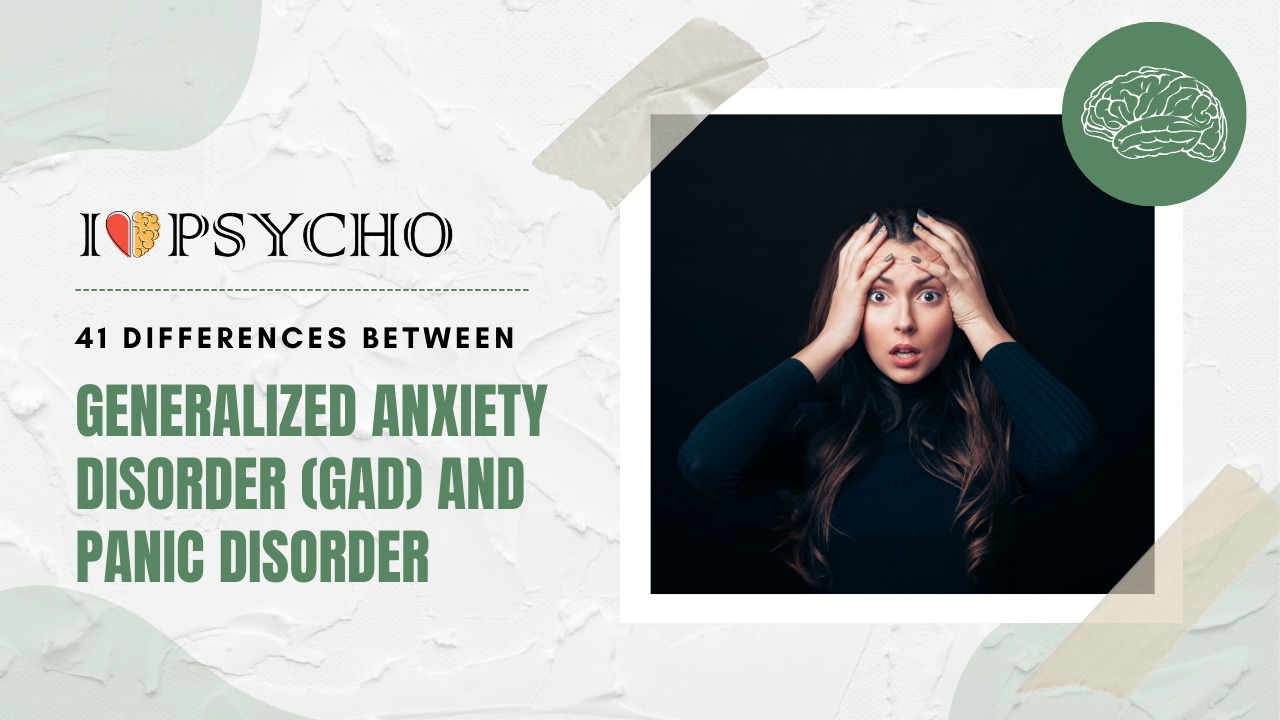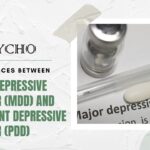Anxiety disorders include GAD and Panic Disorder. Both include extreme and uncontrollable anxiety, although their symptoms, causes, and duration differ. Generalized Anxiety Disorder (GAD) causes excessive concern and anxiety over ordinary events. GAD sufferers struggle to regulate their worry, which can disrupt everyday life. GAD anxiety is broad and chronic, affecting work, relationships, health, and money. Muscle tension, restlessness, impatience, and concentration problems are frequent in GAD. GAD begins gradually and lasts six months or more.
However, Panic Disorder comprises abrupt and severe bouts of dread or panic, typically accompanied by physical symptoms such as a racing heart, shortness of breath, dizziness, and a sense of impending doom. Short-lived panic episodes peak within minutes and are mainly caused by specific conditions. Panic Disorder is more intense and episodic than GAD, with panic followed by calm. Fear of further panic episodes might cause Panic Disorder sufferers to avoid particular locations and circumstances.
The key differences between the diseases are triggers. While GAD is characterized by a general sense of discomfort and concern without specific triggers, Panic Disorder is caused by immediate, severe dread in reaction to specific events or sensations. Panic Disorder can also cause Agoraphobia, when people avoid circumstances or locations they think can cause panic episodes.
Psychotherapy, such as cognitive-behavioral therapy (CBT), can help people understand and control their anxiety, and medicine, like antidepressants, can treat both conditions. Treatment varies on severity and personal taste.
Finally, GAD and Panic Disorder differ in anxiety, causes, and length. GAD is persistent, diffuse anxiety about many issues, while Panic Disorder is acute terror induced by specific events. Accurate diagnosis and therapy need to understand these variances. If you or someone you love has signs of either illness, professional treatment can help manage and improve mental health.
Also Read: 42 Difference Between Anxiety and Depression
Here are the 41 differences between Generalized Anxiety Disorder (GAD) and Panic Disorder:
|
S.No. |
Aspect |
Generalized Anxiety Disorder (GAD) |
Panic Disorder |
|
1 |
Core Symptom |
Excessive worry and anxiety about various life areas |
Recurrent and unexpected panic attacks |
|
2 |
Anxiety Triggers |
Worries are often related to everyday life concerns |
Panic attacks typically have no apparent triggers |
|
3 |
Duration of Anxiety |
Persistent and chronic, lasting for at least 6 months |
Intense, sudden, and short-lived panic attacks |
|
4 |
Physical Symptoms |
Physical symptoms are mild and diffuse |
Intense physical symptoms during panic attacks |
|
5 |
Key Symptoms |
Restlessness, muscle tension, fatigue, and irritability |
Palpitations, sweating, trembling, and chest pain |
|
6 |
Cognitive Focus |
Excessive worrying and rumination |
Fear of having future panic attacks |
|
7 |
Onset |
Gradual onset often in childhood or adolescence |
Sudden onset usually in late adolescence or early adulthood |
|
8 |
Frequency of Attacks |
Continuous worry with no discrete attacks |
Sudden and recurrent panic attacks |
|
9 |
Anticipatory Anxiety |
Constantly worried about potential future problems |
Anxiety often revolves around the fear of panic attacks |
|
10 |
Sleep Disturbance |
Difficulty falling asleep or staying asleep |
Panic attacks can disrupt sleep patterns |
|
11 |
Comorbid Conditions |
Often co-occurs with depression and other anxiety disorders |
Can co-occur with other anxiety disorders and agoraphobia |
|
12 |
Triggers for Anxiety |
Typically triggered by real-life stressors and problems |
Panic attacks often occur unpredictably |
|
13 |
Fear of Fear |
Less focused on the fear of having a panic attack |
Central fear is experiencing another panic attack |
|
14 |
Physical Symptoms |
Less intense physical symptoms |
Intense physical sensations during panic attacks |
|
15 |
Avoidance Behavior |
Avoidance of situations is less common |
Avoidance of places or situations due to fear of panic attacks |
|
16 |
Panic Attack Duration |
No distinct panic attacks |
Panic attacks are sudden and typically brief |
|
17 |
Impact on Daily Life |
Chronic anxiety can impair daily functioning |
Interferes with daily life during panic attacks |
|
18 |
Treatment Approach |
Cognitive-behavioral therapy, medication, and relaxation techniques |
Cognitive-behavioral therapy, medication, and exposure therapy |
|
19 |
Medications |
Antidepressants and benzodiazepines may be prescribed |
Antidepressants, benzodiazepines, and beta-blockers are common |
|
20 |
Breathing Difficulty |
Breathing difficulties are less common |
Hyperventilation and shortness of breath are common during panic attacks |
|
21 |
Focus of Worry |
Worries are broad and cover multiple life areas |
Worry is centered on the fear of panic and its consequences |
|
22 |
Restlessness |
Restlessness and muscle tension are common |
Restlessness can occur during panic attacks |
|
23 |
Catastrophic Thinking |
Less likely to engage in catastrophic thinking |
Often engages in catastrophic thinking during panic attacks |
|
24 |
Muscle Tension |
Muscle tension is a common symptom |
Muscle tension can occur during panic attacks |
|
25 |
Impairment in Functioning |
Impairs daily functioning due to persistent worry |
Impairs functioning primarily during panic attacks |
|
26 |
Physical Health Anxiety |
Less likely to focus on physical health concerns |
May have heightened fear of physical symptoms during panic attacks |
|
27 |
Cognitive Behavioral Techniques |
Effective in managing persistent worry |
Focused on managing and reducing panic attack symptoms |
|
28 |
Treatment Duration |
Treatment is often long-term due to chronic nature |
Treatment may be shorter if panic attacks are effectively managed |
|
29 |
Hypervigilance |
Hypervigilance may be present but less pronounced |
Hypervigilance often during panic attacks |
|
30 |
Prevalence |
More prevalent in the general population |
Less prevalent compared to GAD |
|
31 |
Worry Content |
Worries often relate to various aspects of life |
Worry content primarily revolves around panic attacks |
|
32 |
Heart Rate |
Heart rate and arousal levels are typically lower |
Heart rate and arousal levels significantly increase during panic attacks |
|
33 |
Relaxation Techniques |
Beneficial for managing generalized anxiety symptoms |
May be less effective for preventing panic attacks |
|
34 |
Cognitive Distortions |
Common cognitive distortions include catastrophic thinking, overgeneralization |
Common cognitive distortions involve catastrophic thinking, personalization |
|
35 |
Emotional Numbing |
Less likely to experience emotional numbing |
Emotional numbing or detachment during panic attacks is common |
|
36 |
Subtypes |
No distinct subtypes |
May have specific phobia subtype (e.g., fear of public places) |
|
37 |
Fear of Embarrassment |
Less focused on the fear of embarrassment |
Fear of embarrassment during panic attacks is common |
|
38 |
Comorbidity with Agoraphobia |
Less common comorbidity with agoraphobia |
Often comorbid with agoraphobia |
|
39 |
Body Sensations Awareness |
Less focused on bodily sensations awareness |
Heightened awareness of bodily sensations during panic attacks |
|
40 |
Avoidance Patterns |
Avoidance behaviors are often minimal |
Avoidance behaviors related to specific triggers are common |
|
41 |
Cognitive Treatment Focus |
Focuses on managing excessive worrying and rumination |
Focuses on addressing the fear of panic attacks and reducing avoidance behaviors |
Also Read: Intellectual Disabilities: Symptoms, Causes and Treatment
Frequently Asked Questions (FAQS)
Q.1 What is Generalized Anxiety Disorder (GAD)?
GAD is a mental health problem that causes excessive and persistent worry or anxiety about jobs, relationships, health, and daily activities. Worries are hard to regulate and can cause restlessness, muscular tension, and irritation. GAD-related anxieties are disproportionate to the situation and can greatly damage the quality of life.
Q.2 What's panic disorder?
Panic Disorder is characterized by abrupt, acute panic attacks. These episodes sometimes cause a racing heart, shortness of breath, shaking, and a sense of impending doom. Panic episodes can be induced by crowds or restricted settings and peak within minutes.
Q.3 How are GAD and Panic Disorder analyzed?
Professionals diagnose GAD and Panic Disorder after a comprehensive assessment. A licensed therapist or psychiatrist will evaluate the patient’s symptoms, duration, and daily life effects. They may utilize DSM-5 criteria to assess if the person has either disorder.
Q.4 What treatment options are available for these disorders?
GAD and Panic Disorder are treatable. Treatments include counseling and medication. CBT is a typical treatment that helps people recognize and confront problematic thinking patterns and create coping techniques. Based on symptom intensity, SSRIs or benzodiazepines may be recommended.
Q.5 Can GAD or Panic Disorder be prevented?
Strategies can lessen the likelihood of certain problems, but they may not prevent them. Healthy lifestyle choices including exercise, nutrition, and sleep can reduce stress. Learning stress management and getting counseling for anxiety or panic can also help avoid it.









